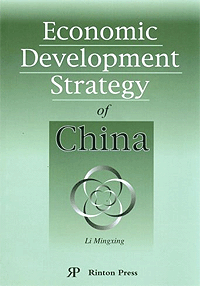| |

|
 |
|
|
Economic Development
Strategy of China
Li Mingxing |
282 pages, 9.5x6.75 inches
May
2004 Softcover
ISBN 1-58949-042-8
US$46 |
|
|
|
Buy It |
|
|
 
This book presents China's economic development in three
stages: The strategy of preferential development of
heavy industry under the planned economic systems in
1949-1979; the strategy of balanced development under
the policy of reform and opening-up in 1980-2000; and
the strategy of new-style industrialization in the
context of innovations in institution-building as well
as science and technology in 2001-2020.

undergraduate and graduate students, teachers,
researchers interested in Chinese Economics, Chinese
government officials, and others. |

Foreword
PART I: THE STRATEGY OF PREFERENTIAL DEVELOPMENT
OF HEAVY INDUSTRY AND THE PLANNED ECONOMIC SYSTEM FROM
1949 TO 1979
CH.1 The Strategy of
Preferential Development of Heavy Industry
1.1 Background of the strategy: the world's cold war
structure and a fragile economic foundation
1.2 Target of the strategy: overtake the UK and the US
1.3 Measures under the strategy: the planned economic
system and the mechanism of preferential development of
heavy industry
CH.2 Practical Benefits of the
Strategy of Preferential Development of Heavy Industry
2.1 Macroeconomy: the establishment of a planned
economic structure and the realization of rapid
industrial growth
2.2 Structural characteristics: massive developments of
state-owned heavy industries and a distortion in the
aggregate structure
2.3 Growth factors: management elements split in
development, heavy industrial investment
CH.3 Limitations of the
Strategy of Preferential Development of Heavy Industry
3.1 Economic structural anomaly constrains growth
3.2 A waning accumulation mechanism subdues the impetus
for expansion
3.3 Irrational resource allocation hinders economic
efficiency
PART II: THE STRATEGY OF BALANCED DEVELOPMENT
AND THE REFORM AND OPENING-UP, 1980-2000
CH.4 The strategy of Balanced
Development
4.1 Background of the strategy: an environment for
peaceful developments and "focusing on the central task
of economic constructions"
4.2 Target of the strategy: modest level of prosperity
4.3 Measures under the strategy: the policy of reform
and opening-up and the mechanism of coordinated
development |
CH.5 Practical Results of the Strategy of
Balanced Development
5.1 Macroeconomy: preliminary establishment of
the market system, dramatically enhancing
overall economic competitiveness
5.2 Structural characteristics: aggregate
structure works towards equilibrium while
structural standards remain low
5.3 Growth factor: joint push by systems and
factors, coordinated haul by domestic and
external demands
CH.6
Limitations of Extensive Growth
6.1 Structural conflict hinders economic
benefitss
6.2 System imperfection inhibits vitality for
development
6.3 Extensive growth restrains quality of
development
PART III: NEW-STYLE INDUSTRIALIZATION
STRATEGY AND TWO INNOVATIONS FOR 2001-2020
CH.7 New-style Industrialization
Strategy
7.1 Background of the strategy: new trend of
the world economy and new challenges to China's
economy
7.2 Target of the strategy: an all-round
well-off society
7.3 Connotations of the strategy: triple
integrated development and three organic
combinations
CH.8 Measures under
the New-Style Industrialization Strategy
8.1 Structural optimization and realization of
integrated development
8.2 Perfecting mechanisms to fully enjoy the
benefits of globalization
8.3 Innovative technology to propel intensive
economic growth
CH.9 Prospects for
China's Economy in the 21st Century
9.1 Macroeconomics: innovating the system, and
comprehensively building a well-off society
9.2 Structural characteristics: structural
optimization and accentuating the significance
of the division of labor
9.3 Key growth factors: pushed by "two
resources" and driven by "two markets"
Bibliography
|
|

Mingxing Li,
a graduate of Jilin University, studied in Japan and
United Kingdom from 1990 to 1995, for his MA and PhD
degrees in Economics. He worked, as a deputy division
chief and division chief, for the National Economic and
Trade Commission of China. He is currently the Head of
the Department of International Economy, the Economic
Research Center of the State-owned Assets Supervision
and Administration Commission of the State Council. He
also works as a special researcher for Chinese Academy
of Social Sciences, and he serves as a financial and
economic observer for the national TV station, channel
CCTV. In 2002, Dr Li was elected as a representative to
the 16th National Congress of the CPC. As a principal
investigator, Dr Li was involved in many key researches
at the national level with topics such as "A Study of
Deng Xiaoping Theory and the Transformation of China's
Economic System", "A Study of Measures for
China's Accession to the WTO", "An Outline of
State Industrial Technology Policy" and .... The
documents that Dr Li compiled include "A Study of the
Development of Chinese Enterprises and Groups" and "The
Operation Strategies of the World's Top 500 Enterprises
in China".
|
|
|
|

